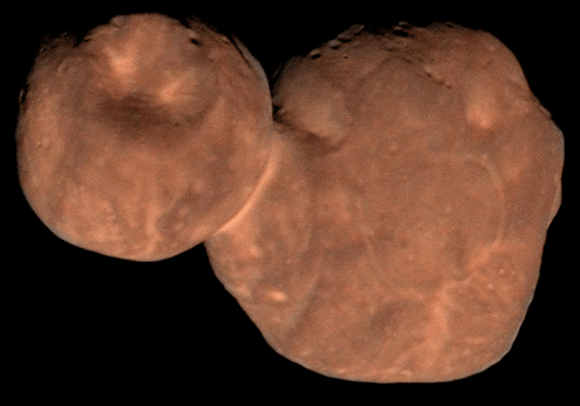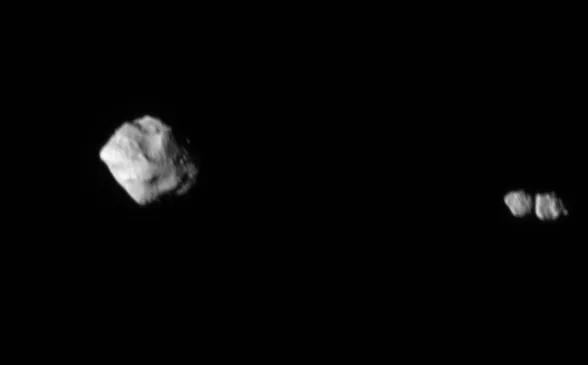Lucy’s images of asteroid Dinkinesh are the gift that keeps on giving. First, it was the discovery of a smaller companion. Now, it turns out that the companion itself is a contact binary. That’s two smaller objects touching each other as they orbit with Dinkinesh. So, how did they get that way?
NASA describes the companion as “unanticipated”, although according to Lucy project scientist John Spencer, they’re actually pretty common in the solar system. “We just haven’t seen many up close, and we’ve never seen one orbiting another asteroid,” he said.
Spencer and the team thought there might be something odd about Dinkinesh, given that it was showing some pretty strange brightness variations as the spacecraft got closer. “It gave us a hint that Dinkinesh might have a moon of some sort, but we never suspected anything so bizarre!”
Dinkinesh itself is an interesting target and part of Lucy’s target population of Jupiter Trojan asteroids. It orbits in the Main Asteroid Belt at an average distance of 2.1 AU. Jupiter Trojans make up a distinct population of asteroids trapped in Jupiter’s orbit. They date back to the origins of the Solar System and can provide insight into conditions that existed some 4.5 billion years ago.
Hints About Asteroid Moons
As news of the images spread across the Internet, people began commenting about “moon-moons” to describe Dinkinesh’s companions. Of course, a lot of discussion centered on how such a binary pair could occur. One comment on X, by Michigan State University planetary scientist Seth Jacobson, referenced his 2011 thesis work focused on modeling similar systems. Understanding what causes such “kissing asteroids” as the Dinkinesh moons, requires a great deal of observation. That’s what Lucy’s doing now.
Jacobson looked at “rotationally fissioned” asteroids, which form when two bodies “fission” as they reach a certain limiting rotational speed. That is, they slowly move apart, but appear tidally locked together. His 2011 paper looked at ideal cases of these objects as sources of then-current observations of small systems.
The work focused on so-called “rubble pile” asteroids and their physical characteristics and gravitational interactions. It involves looking at near-Earth asteroid evolution via something called the YORP (Yarkovsky–O’Keefe–Radzievskii–Paddack) effect. The Yarkovsky part of the effect basically describes how orbits of small asteroids are changed by a tiny amount of thrust created as sunlight re-radiates off their uneven surfaces. Since the amount of thrust is so small, it takes a long time to make big changes in the orbit. The effect also changes an asteroid’s spin rate, albeit slowly. The additional factors (added by other researchers looking into the effect) include any possible effects on asteroid orbits and obliquities. This happens to individual asteroids as well as floating rubble piles, with each piece being affected as well as the aggregate.
So, in addition to collisions that shape asteroids, sunlight, and gravitational effects contribute to their evolution. And, in the case of the recent Lucy images, we see direct evidence of that.
Kissing Asteroid Moons
So, how does this relate to Dinkinesh’s moon-moons? They definitely look like a contact binary. Over time, they rotated into place together, at least partly driven by the YORP effect. The end result is two moons looking as if they’re “kissing” each other after incident solar radiation and re-radiation drove them together in a long dance. Are they actually touching? Or simply moving together very closely in a rubble pile? If they are simply very close to each other in a mutual gravitational headlock, then perhaps rotational fission played a role.

We’ve seen similar bodies in the solar system, including the strangely shaped Arrokoth in the Kuiper Belt. It’s a contact binary that appears to be doing more than kissing. The two lobes look almost welded together around a narrow “neck”. They probably merged together after getting locked together in a gravitational (tidal) dance. Unlike Dinkinesh’s companions, Arrokoth’s two lobes are not the same size.
Why Dinkinesh?
Dinkinesh is about 790 meters across, and its moon-moons are much smaller and don’t yet have names. This asteroid is part of Lucy’s larger mission to survey Jupiter Trojan asteroids. Interestingly, Dinkinesh was added into the mission timeline as a targeting and tracking test. The spacecraft’s systems not only did that, but also provided excellent imaging over time to give multiple views of this asteroid and its moons from different perspectives.
The results look intriguing for now, giving planetary scientists a lot to chew on. “It is puzzling, to say the least,” said Hal Levison, principal investigator for Lucy. “I would have never expected a system that looks like this. In particular, I don’t understand why the two components of the satellite have similar sizes. This is going to be fun for the scientific community to figure out.”
For More Information
NASA’s Lucy Surprises Again, Observes 1st-ever Contact Binary Orbiting Asteroid
Dynamics of Rotationally Fissioned Asteroids: Source of Observed Small Asteroid Systems

